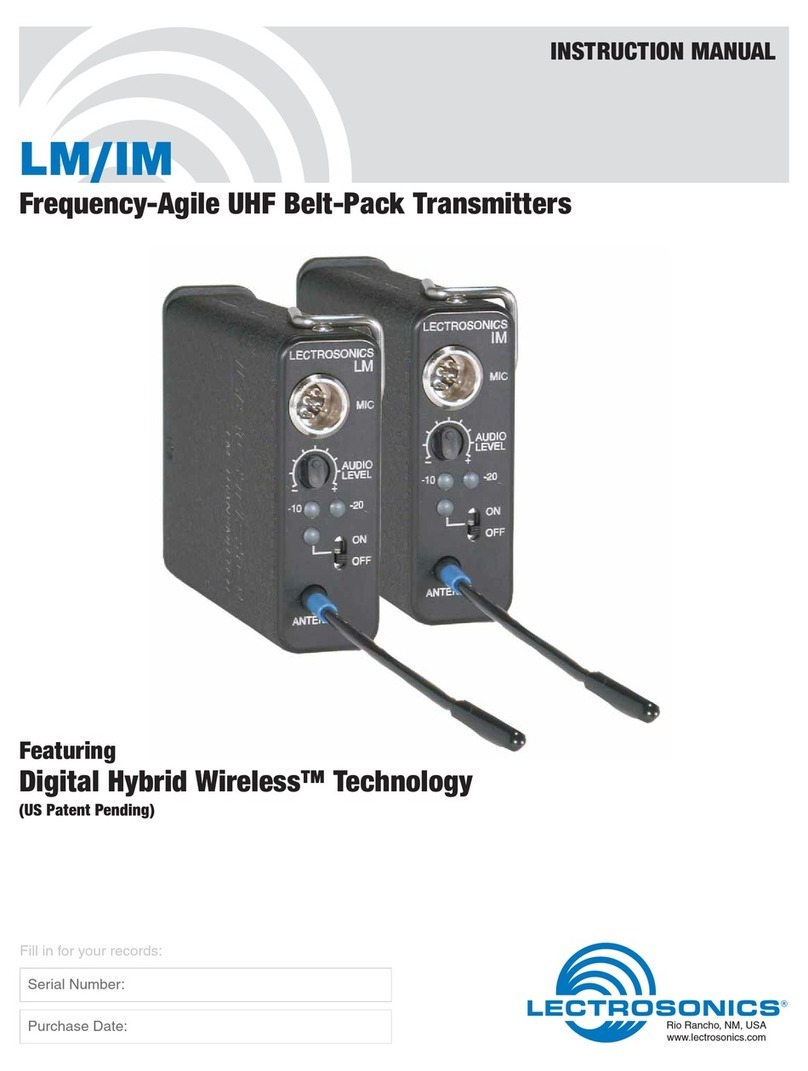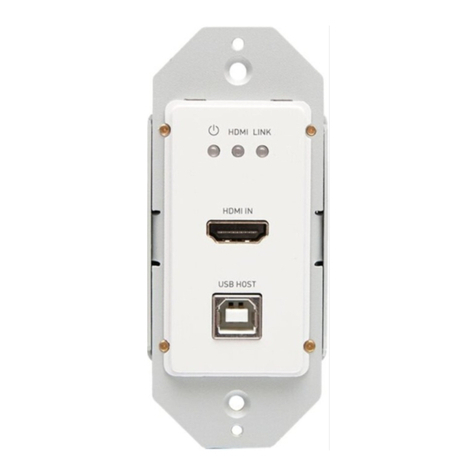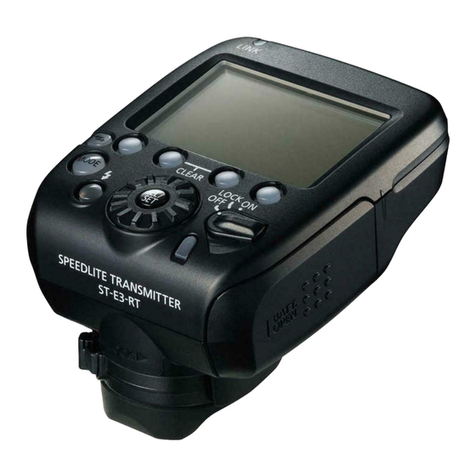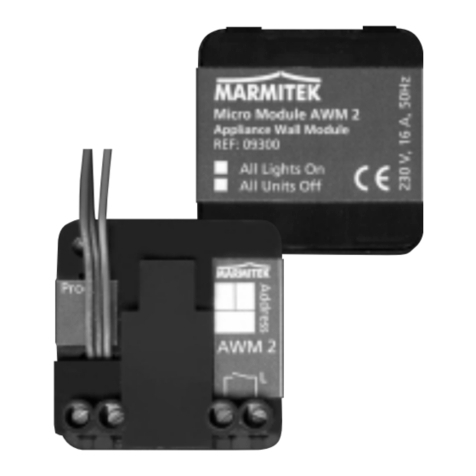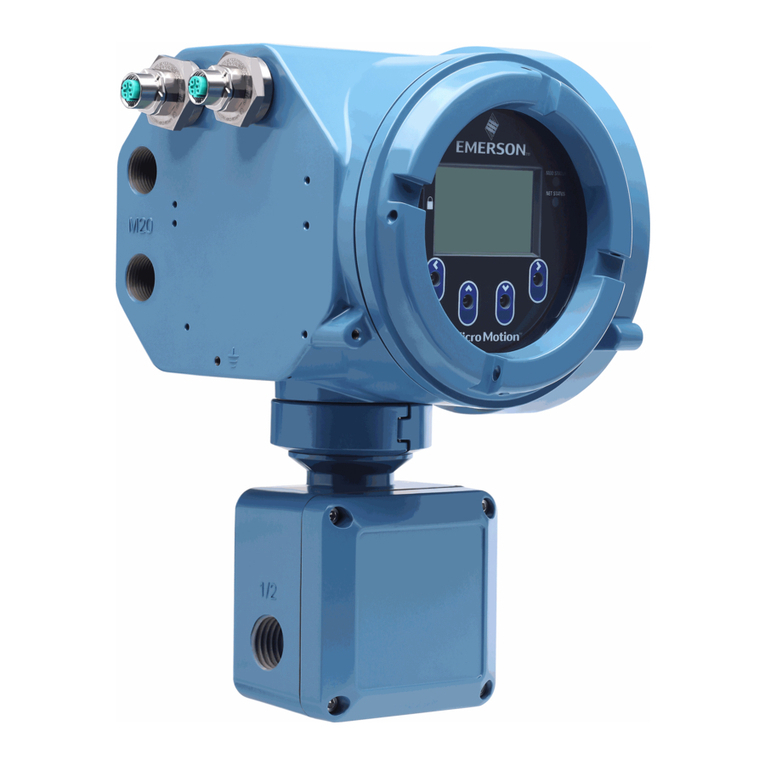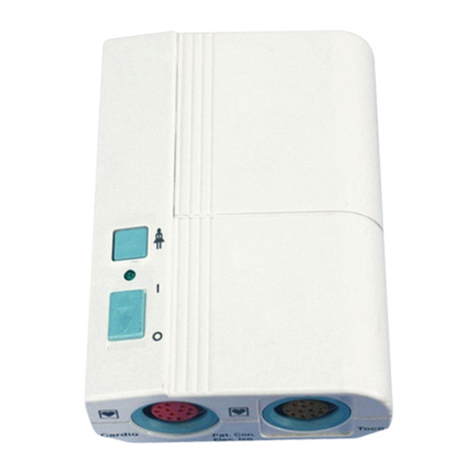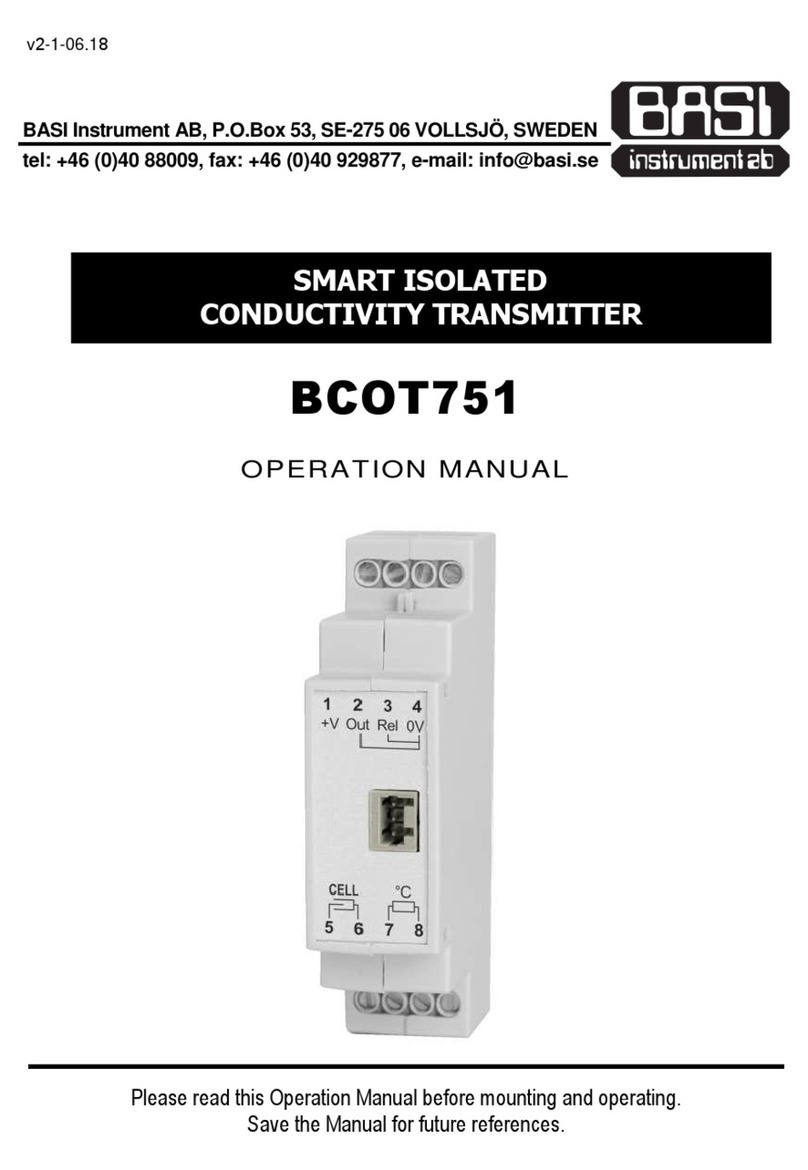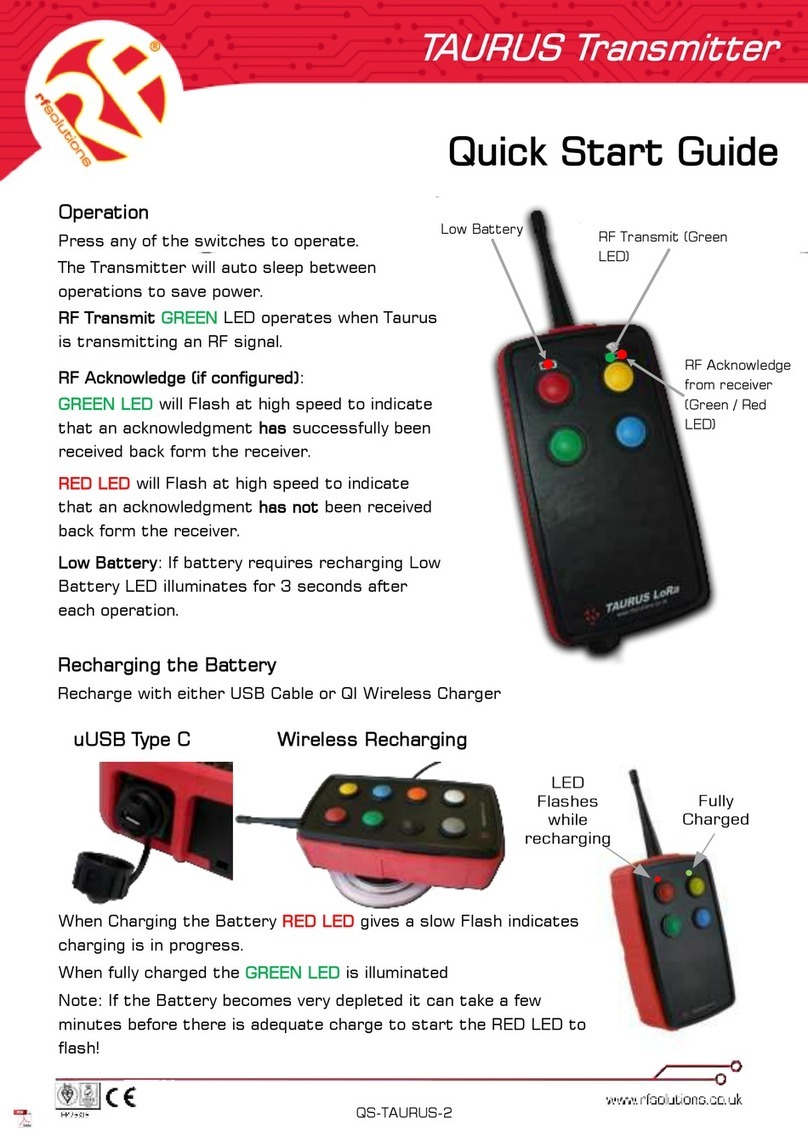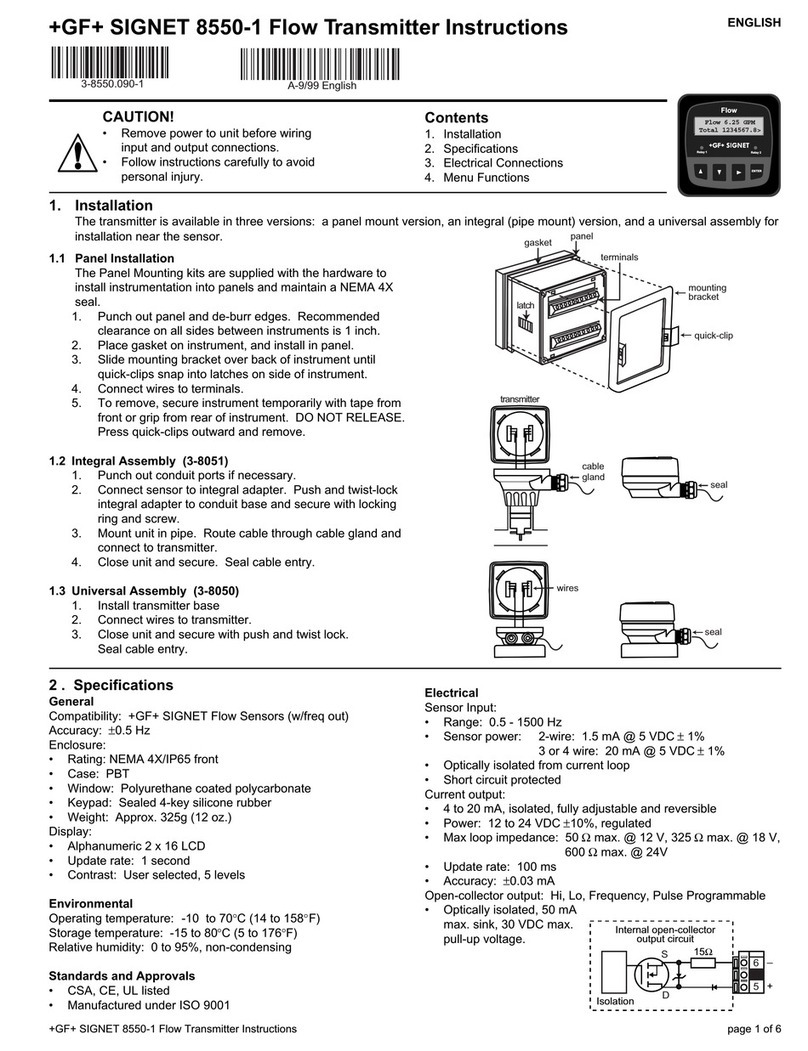AddSecure Tor V User manual

Installation manual Tor V, PDK-11606 version 6.0
May 28, 2019
Tor V
Alarm transmitter
Installation manual

AddSecure Tor V, PDK-11606 2
TABLE OF CONTENTS
1Introduction .............................................................................................................................................................................. 4
2Package contents ......................................................................................................................................................................5
3Conditions.................................................................................................................................................................................5
3.1 Fire alarm installation (EN 54-21:2006)........................................................................................................................... 5
3.2 Alarm installation (EN 50136/SSF 114)..........................................................................................................................5
4Installation ................................................................................................................................................................................. 6
4.1 Fire alarm installation (EN 54-21:2006)........................................................................................................................... 6
4.2 Mounting...............................................................................................................................................................................6
4.3 Antenna for wireless communication ..............................................................................................................................7
5Connections .............................................................................................................................................................................. 8
6Circuitry .....................................................................................................................................................................................9
6.1 Fire alarm installation (EN 54-21:2006)........................................................................................................................... 9
6.2 Alarm installation (EN 50136/SSF 114)..........................................................................................................................9
6.3 Power supply......................................................................................................................................................................... 9
6.4 Alarm inputs .......................................................................................................................................................................10
6.5 Relays (outputs)..................................................................................................................................................................11
6.5.1 Error indication .............................................................................................................................................................11
6.5.2 Indication of ongoing alarm.......................................................................................................................................11
6.6 Ethernet connection (broadband) ..................................................................................................................................12
6.6.1 Firewall configuration...................................................................................................................................................12
6.7 Wireless connection...........................................................................................................................................................12
6.8 Reading the signal strength ..............................................................................................................................................12
6.9 Serial ports...........................................................................................................................................................................13
6.9.1 Example of a cable for connecting the control panel ...........................................................................................13
6.9.2 Example of a null modem cable for connecting a PC..........................................................................................13
6.10 Analogue dialler .................................................................................................................................................................14
7Testing the fire alarm installation (EN 54-21:2006).........................................................................................................14
8Maintenance ............................................................................................................................................................................15
9Troubleshooting .....................................................................................................................................................................15
9.1 All diodes are blinking at the same time ......................................................................................................................15
9.2 The A diode is blinking and the C diode is turned off.............................................................................................15
9.3 Weak signal strength .........................................................................................................................................................15
9.4 No Internet connection....................................................................................................................................................15
10 Data sheet Tor V ....................................................................................................................................................................16
Appendix –Status indicators for Tor V..........................................................................................................................................17
Appendix –Instructions for measuring the signal strength on a computer............................................................................18
Appendix –Information for the building custodian ...................................................................................................................19

AddSecure Tor V, PDK-11606 3
0700
AddSecure AB, Telefonvägen 30, SE-126 26 HÄGERSTEN
18
2544-CPR-P21517-F01-18 (FIRE)
0700-19-210500-RED (RED)
SBF 110:8
SSF 114 utg. 2
EN 50131-1:2006:A2:2017
EN 50131-10:2014
EN 50136-1:2012+A1:2018
EN 50136:2:2013
EN 54-21:2011
EN 54-21:2006
EN 50130-5:2011
EN 50130-4:2011+A1:2014
Alarm transmission and fault warning routing equipment for
intruder and fire alarm systems installed in buildings.
Notified body: Applica Test & Certification
EN 55032:2015
EN 62368-1:2014
EN 62311:2008
EN 301 489-1 V1.9.2
EN 301489-52 V1.1.0 (on approval)
EN 301 908-14 V11.1.2
EN 301 511 V12.5.1
Notified body: Phoenix Testlab
Tor V: 80 321 335
Technical data: See this document

AddSecure Tor V, PDK-11606 4
1INTRODUCTION
The Tor V alarm transmitter is connected to an appropriate alarm transmission service, which is
determined by the requirements for the alarm system. The transmitter itself does not need to be
programmed; all the programming is done in the service. Communication depends on the
version of Tor V and the connection: wired by Ethernet and/or wireless over the 2G, 3G, and
4G mobile data network. Communication is encrypted by AES to prevent unauthorized
interception of or tampering with sent messages.
Tor V is constructed to securely transmit fire alarm, intruder alarm, and technical alarm signals.
In addition, Tor V is equipped with a local Ethernet user interface to transmit IP-based
communication from equipment connected locally.
Several service options can be selected for Tor V, all of which contain up to 8 alarm inputs.
Depending on the service, the connection can be monitored with error reporting within 20
seconds.
For the alarm transmitter to meet the requirements of SBF 110:8, the delivered service profile
must also comply with the requirements set forth in EN 54:21, including error reporting within
90/180 seconds (wired connection/wireless connection), and the installation is to follow
specific instructions for the installation of fire alarms. See section 3.1 for all conditions.
For the alarm transmitter to meet the requirements of SSF 114/EN 50136, the delivered service
profile must also comply with the requirements set forth in EN 50136, including error
reporting, and the installation is to follow specific instructions for the installation of alarms. See
section 3.2 for all conditions.
Keep an eye out for these two symbols that are used in this manual.
These two symbols indicate a warning or information to be aware of in
terms of special requirements, exceptions, or other items worthy of noting.
AddSecure AB
Telefonplan 30
S-126 26 Hägersten
Phone: +46 (0) 8 685 15 00
Web: http://www.addsecure.com
Technical Support
Phone: +46 (0) 8 685 15 50
E-mail: support@addsecure.com
Every conceivable measure has been taken to ensure the accuracy and completeness of this
documentation. However, as errors can never be fully excluded, we always appreciate any
information or suggestions for improving the documentation.
We wish to point out that the software and hardware terms as well as the trademarks of
companies used and/or mentioned in the present manual are generally protected by trademark
or patent. Some components of the software used in the alarm transmitter are licensed under
GPLv2.
© 2018 by AddSecure AB
All rights reserved.

AddSecure Tor V, PDK-11606 5
2PACKAGE CONTENTS
Tor V alarm transmitter in a plastic encasement
This user manual
Commissioning instructions (47IN0039)
Installation manual –Removal detector (47IN0051)
Tor V (alarm transmitter)
Removal detector
Internal antenna
Ethernet cable (shielded)
SIM card
Sticker to mount on the fire alarm (EN 54-21:2006)
Labels to mark the connections and indicators on the alarm transmitter
Screws and plugs for installation
External antenna for 4G (GPRS/EDGE/4G)
Option: AC/DC adapter 230V/24V
.
3CONDITIONS
3.1 Fire alarm installation (EN 54-21:2006)
The service profile of the alarm transmitter is to meet the requirements set forth in
SBF 110:8 (EN 54-21:2006).
The alarm transmitter is to be mounted and connected so that all requirements in SBF
110:8 (EN 54-21:2006) are met.
The pin inputs and relays are connected to meet the requirements set forth in SBF
110:8 (EN 54-21:2006). Use inputs normally closed or with a resistor to detect failure.
The alarm transmitter is to be mounted and voltage supplied from the control panel.
Access to voltage supply from the control panel, with 2A fuses.
Externally mounted antenna with satisfactory signal strength for mobile data
communication.
Marking the outside of the alarm transmitter’s encasement with the included sticker.
Follow the instructions in the following sections: 4.1, 6.1, 6.5 and 7
3.2 Alarm installation (EN 50136/SSF 114)
For security class 2, the following apply:
Tor V in a plastic encasement without a battery backup but with a mounted removal
detector.
The service profile of the alarm transmitter is to meet the requirements set forth in
SSF 114:2/EN 50136.
The pin inputs and relays are connected to meet the requirements set forth in SSF
114:2/EN 50136. Use inputs normally closed or with a resistor to detect failure.
The alarm transmitter is to be mounted and connected so that all requirements set
forth in SSF 114:2/EN 50136 are met.
Access to voltage supply of +12V to +30V with battery backup, with 2A fuses for 12V.
Follow the instructions in the following section: 6.2

AddSecure Tor V, PDK-11606 6
4INSTALLATION
The alarm transmitter is always to be mounted on a fixed, flat surface before it is connected.
There must be sufficient space to connect the antenna and cables to the alarm transmitter.
4.1 Fire alarm installation (EN 54-21:2006)
For a fire alarm installation, it’s easiest to mount the alarm transmitter inside the control panel.
This is so that the installation complies with EN 54-21:2006. Attach the included sticker with
the marking EN 54-21 to the outside of the encasement so that it can be read after the
installation is complete.
4.2 Mounting
Mount the base using three screws using either holes A or B.
Figure 1 - Plastic encasement as seen from below

AddSecure Tor V, PDK-11606 7
4.3 Antenna for wireless communication
Use the external antenna as needed, and place it so that the reception is satisfactory (do not
place in a metal cabinet). Connect the antenna directly into the FME female socket. If the
antenna is placed 5–10 meters from the alarm transmitter, use a coaxial cable of the type RG58.
Note that with wireless transfer over a mobile data network, there must be satisfactory
radio coverage. See the signal strength using a computer (see the appendix) or LEDs
during installation (see 6.8). Satisfactory signal strength is between 14 and 32.
Relieve the various cables (the ones connected to the alarm transmitter) of
stresses by securing them outside the encasement, approximately 10
centimeters away. The plastic encasement also has prepared holes for cable
ties on the bottom of the case.
When the plain text function or analogue dialler from the control panel is
used, the external antenna must always be used so that the telecommunication
signals from the control panel are not disturbed.

AddSecure Tor V, PDK-11606 8
5CONNECTIONS
Figure 1 –Plastic encasement side 1
Figure 2 –Plastic encasement side 2
Figure 3 –Plastic encasement from above

AddSecure Tor V, PDK-11606 9
6CIRCUITRY
Relieve the various cables (the ones connected to the alarm transmitter) of stresses by
securing them outside the encasement, approximately 10 centimeters away. The plastic
encasement also has prepared holes for cable ties on the bottom of the case.
6.1 Fire alarm installation (EN 54-21:2006)
Connect relay 3 (for error indication) to the control panel. See 6.5.1 for connection
instructions as well as a data sheet (see 10) for details regarding the signaling and levels
of the output.
Connect relay 4 (for alarm acknowledgments from the alarm receiver) to the control
panel. See 6.5.2 for connection instructions as well as a data sheet (see 10) for details
regarding the signaling and levels of the output.
Connect the control panel’s output for error indication to optional alarm input.
Balance the output from the control panel with 4.7kΩ.
6.2 Alarm installation (EN 50136/SSF 114)
To meet security grade 3, the removal detector must be mounted. See the included instructions
on how to mount it (Installation manual –Removal detector 47IN0051).
Connect relay 3 (for error indication) to the control panel. See 6.5.1 for connection
instructions as well as a data sheet (see 10) for details regarding the signaling and levels
of the output.
Connect relay 4 (for alarm acknowledgments from the alarm receiver) to the control
panel. See 6.5.2 for connection instructions as well as a data sheet (see 10) for details
regarding the signaling and levels of the output.
6.3 Power supply
PIN
1
Primary voltage supply
+12V to + 30V DC, with 2A fuses at 12V DC
2
Ground
3–4
Not used
5
Secondary voltage supply
See pin 1
6
Ground
Figure 5 - Power
supply terminal
block

AddSecure Tor V, PDK-11606 10
6.4 Alarm inputs
The alarm transmitter can either be digital and trigger an alarm when open or closed or analog,
balanced at 4.7kΩ. A number of typical installations are described below.
Figure 4 –Normally open/closed relays
1. Normally open/closed relays
When connecting the digital signals to trigger an
alarm when opening or closing, the inputs are
connected as such.
This connection can keep the control panel
galvanically isolated from the alarm transmitter.
Figure 5 –Balanced analogue
2. Balanced analogue
If the signals that are sent to the alarm transmitter
are analogue, balanced at 4.7kΩ, the resistor is to
be mounted as such.
This connection can keep the control panel
galvanically isolated from the alarm transmitter.
Figure 6 –Voltage of +5V to +12V with
limiting
3. Voltage of +5V to 12V with limiting
In some cases voltage must be limited on the
alarm port in the alarm transmitter in option 3. If
that is the case, insert a 5.1V Zener diode as
illustrated in the sketch.
This connection can keep the control panel
galvanically isolated from the alarm transmitter.
Figure 7 –Voltage of -12V to -5V
4. Voltage of -12V to -5V
The connection works no matter whether the
output from the control panel is low ohmig
(<500Ω) or high ohmig (>500Ω) when there is an
absence of voltage.
This connection galvanically couples the control
panel and the alarm transmitter.

AddSecure Tor V, PDK-11606 11
Figure 8 –Open-collector transistor
5. Open-collector transistor
The collector on the control panel’s
output must be connected to the alarm
input’s signal side.
This connection can keep the control panel
galvanically isolated from the alarm transmitter if
the transistor is, for example, the output from an
optically-coupled isolator.
An order must be placed to change the service or the control of the alarm. Contact AddSecure
for additional information about orders and changes to the alarm transmitter. Local
programming is not necessary.
6.5 Relays (outputs)
6.5.1 Error indication
Relay 3 (FAULT) is used to signal errors when the alarm transmitter is used for fire alarms.
Connection: Connect relay 3 with pin 11 (normally open) and pin 9 (common) to the alarm
panel at the appropriate input so that the alarm panel can detect a short circuit/open circuit
on the connection.
Status: Ok.
The relay is closed when the alarm transmitter is fully functional.
Status: Error.
The relay opens in the event of an error or when the alarm transmitter is not fully
functional; for example, if there is a restart or when the alarm cannot be sent or when
no acknowledgment is received from the alarm receiver.
6.5.2 Indication of ongoing alarm
Relay 4 (ACK) is used when the alarm transmitter is configured for fire alarms and to indicate
that the alarm transmitter has ongoing alarms.
PIN
FUNCTION
1
Relay 1 –Normally closed
2
Relay 2 –Normally closed
3
Relay 1 –Common
4
Relay 2 –Common
5
Relay 1 –Normally open
6
Relay 2 –Normally open
7
Relay 3 –Normally closed
8
Relay 4 –Normally closed
9
Relay 3 –Common
10
Relay 4 –Common
11
Relay 3 –Normally open
12
Relay 4 –Normally open
Figure 9 –Relay terminal block

AddSecure Tor V, PDK-11606 12
Connection: Connect relay 4 with pin 12 (normally open) and pin 10 (common) to the alarm
panel at the appropriate input so that the alarm panel can detect a short circuit/open circuit
on the connection.
Status: Normal.
The relay is opened when all fire alarms have been reset and acknowledged from the
alarm receiver.
Status: Alarm in progress
The relay closes then fire are in progress.
6.6 Ethernet connection (broadband)
Whenever Ethernet is included in the service, ETH0 is to be connected to Internet or the
customer network for external communications for the service.
6.6.1 Firewall configuration
All communication, keep state, is initiated by the alarm transmitter to the service platform.
FROM
(Sender)
TO
(Listener)
DESTINATION
PORT
PRUPOSE
Tor V
85.117.160.240/28,
85.117.163.239,
85.117.163.240/28
7190, 7195 / TCP
and UDP
AddSecure alarm service
85.117.160.240/28 corresponds to: 85.117.163.240/28 corresponds to:
85.117.160.240 –85.117.160.255 85.117.163.240 –85.117.163.255
6.7 Wireless connection
The alarm transmitter is equipped with an FME male connector for an external antenna. The
external antenna is to be equipped with an FME female connector.
6.8 Reading the signal strength
The signal strength can be read when the alarm transmitter’s power supply is restored after an
absence of voltage. The LED status indicates the current strength in four steps. The highest
value indicates the current signal strength. For more details, see the appendix.
INDICATOR
SIGNAL STRENGTH
SATISFACTORY
DIODE COLOR
LED A
>25
Yes
Green
LED B
20–25
Yes
Yellow
LED C
14–19
Yes
Red
LED D
0–13
No
Red
To return to normal mode, press the opening tamper switch for five seconds or put on the
cover so that the switch for the opening tamper is pushed down.
Note that the alarm transmitter does not work when you are reading the
signal strength. The alarm transmitter cannot send any alarms, and the alarm
center will be notified that the alarm transmitter is turned off.

AddSecure Tor V, PDK-11606 13
6.9 Serial ports
Whenever serial ports are included in the service, S2 is connected to the serial equipment. The
connector is of the type RJ12, and the electrical user interface is RS232.
Note that serial interface is only for additional information. You must use the
input interfaces to follow the regulations (EN 54-21:2006, EN 50136/SSF
114)
6.9.1 Example of a cable for connecting the control panel
A 5-meter ready-to-go is available as an option and can be ordered. Article number: 80 321 329
6.9.2 Example of a null modem cable for connecting a PC
S2
NAME
FUNCTION
1
Tx
Transmit
2
Rx
Receive
3
RTS
Request to send
4
CTS
Clear to send
5
Power
+5VDC
6
GND
Ground
PIN CPU
CABLE
PIN
CONTACT
FUNCTION
1
Green
3
Tx
→
Tx
2
Yellow
2
Rx
←
Rx
3
Orange
7
RTS
→
RTS
4
Brown
8
CTS
←
CTS
5
Red
+5VDC
6
Black
5
GND
GND
PIN CPU
PIN
CONTACT
FUNCTION
1
2
Tx
→
Rx
2
3
Rx
←
Tx
3
8
RTS
→
CTS
4
7
CTS
←
RTS
5
+5VDC
6
5
GND
GND
Figure 11 –Example of a null
modem cable
Figure 10 –Example of cable
for control panel

AddSecure Tor V, PDK-11606 14
6.10 Analogue dialler
The alarm transmitter acts as a switchboard and picks up automatically when the control panel
dials using the modem’s output. If the control panel sends information in SIA format or
Contact ID (CiD), it is read and then forwarded to the connected alarm center. For this to
happen, you need to have ordered the plain text SIA service or Contact ID. The control panel
is to be programmed with an optional telephone number, consisting of six (6) digits.
Connecting the control panel with an analogue dialler is done with the tele
terminal pair; see Figure 12. The number of the pin is not important.
Transferring alarms through the control panel’s telephone connection
(PSTN) is also called dial-capture. With this service, the alarm transmitter
acts as an analogue telephone network, which it simulates by:
Producing line voltage (approx. 30 volt).
Generating a dial tone when the connected control panel picks up the receiver.
Receiving DTMF signals from the control panel (number dialing).
The next step in receiving a SIA or Contact ID message that the control panel transmits
through its telephone connection is for the alarm transmitter to simulate an alarm receiver.
It does this by sending and receiving the signal that the SIA or Contact ID protocol uses. In
this way, the alarm transmitter receives and acknowledges messages that the control panel sends
through its telephone connection. After the transmission from the control panel is complete,
the message is stored in the alarm transmitter and is forwarded through AddSecure’s system to a
preset alarm receiver. The alarm transmitter deletes the locally stored messages when the system
acknowledges that the messages have been forwarded on.
Note that dialler interface is only for additional information. You must use
the input interfaces to follow the regulations (EN 54-21:2006, EN 50136/SSF
114)
Must not be connected to the general telephone network (ordinary telephone
jack/PSTN). The telephone line connection can only be connected to the
control panels to use the analogue dialler.
The terminal block supplies 30V of line voltage with a ring signal according to the
PSTN standard.
7TESTING THE FIRE ALARM INSTALLATION (EN 54-21:2006)
To test the communication alarm between the control panel and the alarm transmitter as well
as between the alarm transmitter and the alarm receiver, disconnect the current power supply
for the alarm transmitter. Then check the control panel for errors (see 6.5.1) and with the alarm
receiver for a disruption in communication. Then reconnect the power supply, and check that
the control panel and the alarm receiver have been reset for each alarm.
Figure 12 –
Tele terminal block

AddSecure Tor V, PDK-11606 15
8MAINTENANCE
The alarm transmitter does not require any periodical maintenance.
An order must be placed to change the service or the control of the alarm. Contact AddSecure
for further information about placing orders and making changes to the alarm transmitter.
Local programming is not necessary.
9TROUBLESHOOTING
9.1 All diodes are blinking at the same time
If the alarm transmitter gets its power from the control panel, check that there is no current
limitation for the control panel. The alarm transmitter can use up to 3A at 24V DC during
startup with a built-in battery backup or 2A at 12V DC without a battery backup.
9.2 The A diode is blinking and the C diode is turned off
The alarm transmitter does not have contact with the mobile network. Check the cables and
the antenna. The cables must not be spliced or pinched. The antenna must not be placed in a
steel cabinet, near fluorescent lamps, or close to other equipment that may interfere.
9.3 Weak signal strength
Check the cables and connect the external antenna. The cables must not be spliced or pinched.
The antenna must not be placed in a steel cabinet, near fluorescent lamps, or close to other
equipment that may interfere.
9.4 No Internet connection
Check that the network cable is in ETH0 and that the cable is a patch cable.
Some models of gigabit switches have had problems with the alarm transmitter. If
needed, mount a 10/100 switch between the gigabit switch and the alarm transmitter
to fix the problem.

AddSecure Tor V, PDK-11606 16
10 DATA SHEET TOR V
SECURITY
Classification
Grade 2–4
DP4, SP5
D4 / M4 / T5 / A4 / S2 / I3 (Eth & Radio)
POWER SUPPLY
Type
External power supply compliant with EN 50131-6
Voltage
+12V DC to +30V DC
Current, normal usage (maximum)
150mA (2 A) at 24V
WIRELESS ALARM TRANSFER
Mobile data transfer
2G, 3G, and 4G
Antenna connection
FME female
Maximum cable length
See the specification for the external antenna and cables
ETHERNET INTERFACE
WAN connection
1 unit (ETH0)
LAN connection
1 unit (ETH1)
Connector
Modular RJ45
Speed
10/100 Base-T
Maximum cable length
30 meters
Cable type
CAT5, shielded
SERIAL INTERFACE
RS232
2 units (S1 & S2)
Connector
Modular RJ12
ESPA support
ESPA-4.4.4
Maximum cable length
15 meters
ALARM INPUTS
Inputs
8 analogue or digital inputs with internal pull-up
Maximum cable length
30 meters
Voltage across open input
+5V
Analogue
Balanced 4.7kΩ ±1kΩ
TELECOMMUNICATIONS CENNECTION FOR PLAIN TEXT
Telephone input
1 (pluggable terminal block)
SIA support
SIA DC-03-1990.01
Contact ID support
SIA DC-05-1999.09
Maximum cable length
10 meters
RELAY
Quantity
4 relays with alternating output
Maximum voltage
30 DC
Maximum current
2 A
INDICATORS
LEDs
4
ARC
Protocol
Full functionality
MGXP 1131
SOS Access V4
Without support for SIA & ESPA
MGXP 1129
SOS Access V3
Online
Coordcom
ENVIRONMENT
Temperature (surroundings)
-10 OC till +55OC
Humidity
Maximum 95%, non-condensing
Environmental class
II
PHYSICAL PROPERTIES
Dimensions
249 mm × 220 mm × 55 mm (L × W × H)
Weight
565 g

AddSecure Tor V, PDK-11606 17
APPENDIX –STATUS INDICATORS FOR TOR V
When powering up from an absence of voltage and before the tamper spring is
pushed down, table 1 applies. After the spring is pushed down and the signal
strength has been shown, table 2 applies. When warm booting the transmitter, the
signal strength is not displayed and table 2 applies directly.
LED function during power-up
1. LED A blinks at start. Other LEDs are off.
2. When the alarm transmitter has contact with the mobile network, LED A’s light is
solid.
3. If the alarm transmitter does not have contact with the mobile network or if the signal
strength cannot be measured, LED D blinks quickly.
4. The diodes indicate the signal strength of the mobile data network; see Table 1.
5. To return to normal mode, push down the opening tamper switch for five seconds or
put on the cover so that the switch for the opening tamper is pushed down.
6. The LEDs display as normal no matter whether the interference protection is affected.
Table 1 (signal strength).
Indicator
Status
Signal strength
Satisfactory
LED color
LED A
On
>25
Yes
Green
LED B
On
20–25
Yes
Yellow
LED C
On
14–19
Yes
Red
LED D
On
0–13
No
Red
LED D
Blinking
quickly
Cannot be measured
No
Red
Table 2 (normal display).
LED A (Green)
Mode
Description
Off
Indicates that the alarm transmitter does not have power.
Double blinking
Indicates that the alarm transmitter does not have a mobile module or is in the process of
starting up.
Blinking
The alarm transmitter has no contact with the mobile operator.
Solid
The alarm transmitter is connected to a mobile operator.
LED B (Yellow)
Mode
Description
Off
Not used.
LED C (Red)
Mode
Description
Off
The alarm transmitter has no contact with the alarm service via mobile data.
Blinking
The alarm transmitter has contact via the EDGE service.
Solid
The alarm transmitter has contact with the service via GPRS.
LED D (Red)
Mode
Description
Off
The alarm transmitter has no outstanding alarms.
Solid
The alarm transmitter has outstanding alarms.

AddSecure Tor V, PDK-11606 18
APPENDIX –INSTRUCTIONS FOR MEASURING THE SIGNAL STRENGTH ON
A COMPUTER
These instructions describe a general configuration for measuring the GSM signal strength on a
computer. The measurement is only available before the alarm transmitter is commissioned;
afterward, this function is turned off.
Requirements
To measure signal strength, you need:
Computer with a browser
Crossover Ethernet RJ45 TP
network cable
Instructions
Here are only the details necessary to
measure signal strength in your web
browser.
1. Configure your computer for DHCP (you automatically get an IP address between
172.20.20.20 and 172.20.20.250).
2. Connect the computer to ETH 1 in the Tor V with a crossover network cable
(Ethernet RJ45 TP).
3. Connect to this address using your browser: http://172.20.20.1:3080
You now see a number between 0 and 31. The number corresponds to the signal strength that
the alarm transmitter currently has. The page is updated continuously.
If you need help configuring the computer, please turn to the IT department at your company
and give them these instructions.

AddSecure Tor V, PDK-11606 19
APPENDIX –INFORMATION FOR THE BUILDING CUSTODIAN
IMPORTANT! Information about test alarms related to disturbances
With the service you have, any triggered alarms MUST be acknowledged by your alarm center.
If there is a disturbance that causes the communication between the alarm transmitter and the alarm
center to not work, the alarms will be stored in the alarm transmitter and sent as soon as the disturbance
has been fixed. This is to always ensure that you know when the alarm has been triggered.
Example: You are notified by the alarm center or through, for example, AddView that there is a
disturbance causing your service to not work.
The alarm center will ask you to trigger a test alarm. The alarm will be stored and sent as soon as the
service is running again.
Naturally this also applies to intruder alarms; the alarm center takes measures according to the above
routine.
Speak with your electrician about how you easiest conduct a test alarm.
AVOID triggering the fire alarm when there is a disturbance!
Instead trigger a “technical error.” Otherwise the alarm center will notify Rescue Services
when the disturbance has been fixed and the alarm comes in.
Rescue Services considers this to be a false alarm and will charge you for this.

AddSecure Tor V, PDK-11606 20
STOCKHOLM • OSLO • LONDON • GÖTEBORG • MALMÖ • ESPOO • ZUG
WWW.ADDSECURE.COM
Table of contents
Other AddSecure Transmitter manuals

